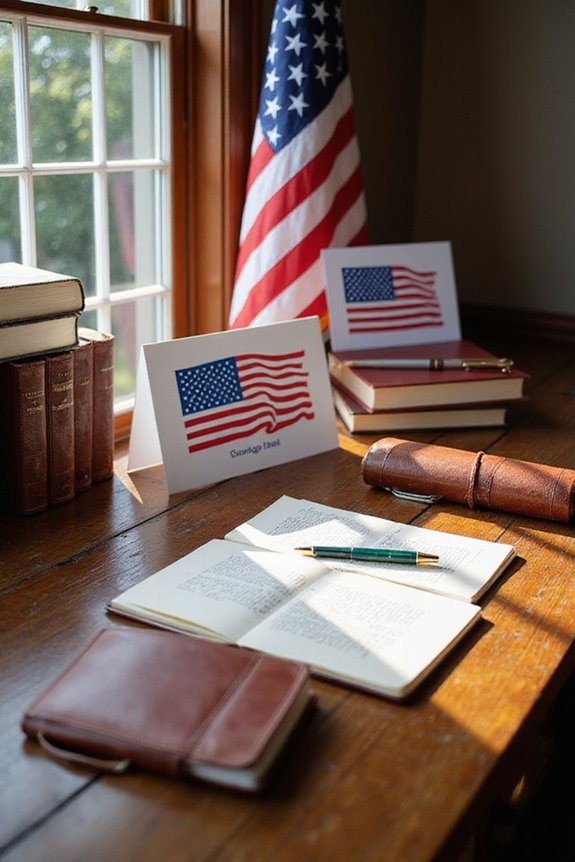Political event badges and passes are essential for campaigns. They serve to:
- Visually represent supporter allegiance and improve organization.
- Provide identification for staff and volunteers, enhancing security.
- Foster unity and enthusiasm among attendees, displaying candidate imagery and slogans.
- Distinguish authorized personnel, streamlining logistics at events.
We see the evolution from 19th-century tokens to modern digital badges. Each type plays a unique role in enhancing campaign effectiveness. Further details await you as we explore this topic.
Key Takeaways
- Political event badges serve as visual identification for attendees, enhancing organization and security during political campaigns and events.
- Digital badges offer instant updates and advanced security features, making them increasingly popular for modern political events.
- Physical badges provide a tangible keepsake for attendees, reinforcing their connection to the campaign or event.
- Customization options for badges include logos, slogans, and QR codes, ensuring effective branding and functionality.
- Badges encourage supporter engagement by showcasing allegiance, fostering unity among attendees at political gatherings.
History and Evolution of Political Badges
The history and evolution of political badges reflect significant changes in campaign strategies and voter engagement over time.
- Early political badges emerged in the mid-19th century as tokens of voter allegiance, with the 1840 Harrison campaign popularizing their use.
- These badges often featured holes for pinning, serving as public statements of support.
- By 1860, photographic elements like tintypes enhanced badge symbolism, connecting voters visually with candidates.
- The late 1860s saw the shift to cheaper paper photographs, driven by advancements in photography.
- The 1896 McKinley-Hobart campaign highlighted badges’ historical significance in issue advocacy, particularly regarding monetary policy. The introduction of colorful options in campaign materials further amplified the appeal of these badges, allowing them to stand out in the evolving political landscape. Additionally, these badges served as early forms of political communication, influencing voter engagement long before the rise of modern media strategies.
- As badges evolved, they became essential tools for political expression, illustrating voter identity and fostering engagement in elections.
Types and Materials of Political Badges
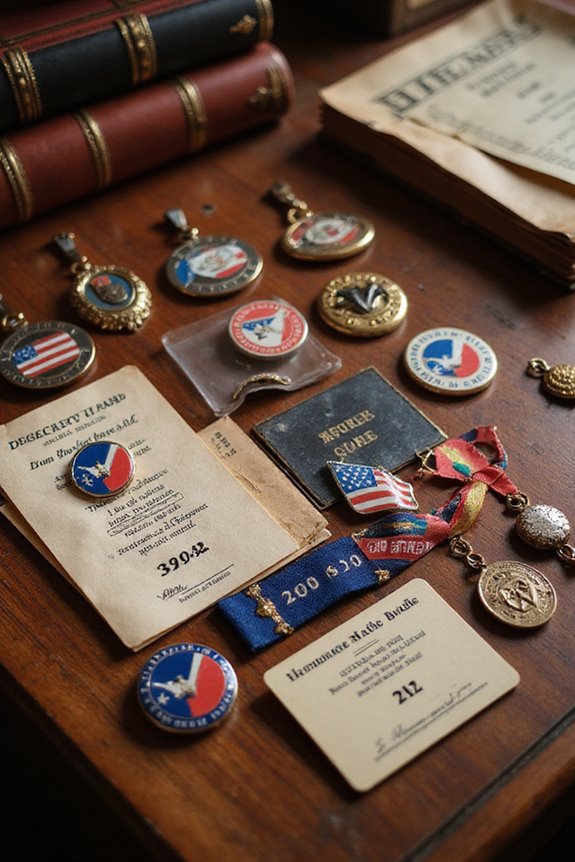
When we explore the types and materials of political badges, it’s evident that these items play an essential role in campaign strategies and voter representation.
Types of Political Badges
- Pinback Buttons: Most common, featuring a metal shell and paper face.
- Lapel Studs: Worn through a lapel hole, popular in the late 1800s.
- Gold Bugs: Unique shapes symbolizing specific campaigns.
- Jugates: Display paired images of candidates on badges.
- Custom Campaign Buttons: Modern, customizable promotional materials.
Materials Used
- Metal Shell: Typically steel or tin.
- Celluloid: Protects the paper design and can be subject to cracking defects.
- Paper Inserts: Feature imagery or slogans.
- Metal Pins and Shanks: Used for fastening.
- Ribbons and Frames: Enhance appearance and significance.
Badge symbolism enhances their impact during political campaigns.
Functions and Uses in Political Campaigns
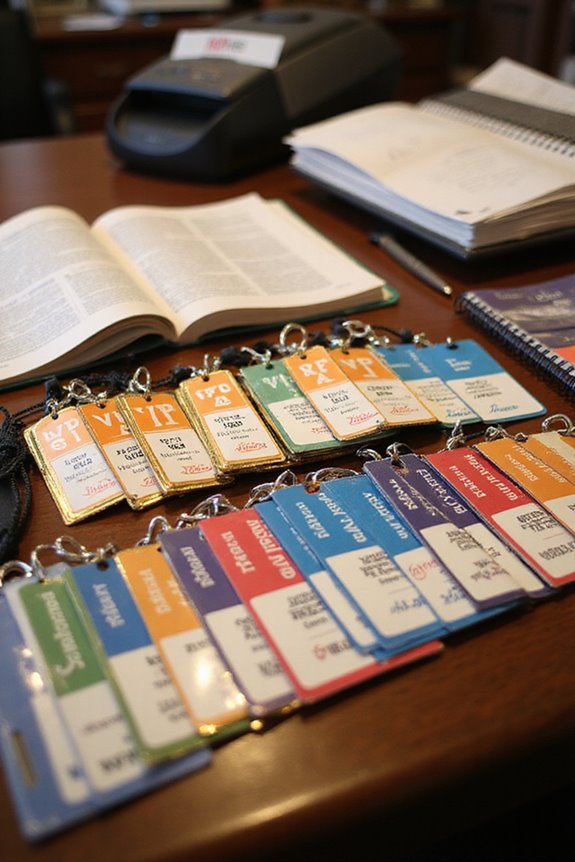
In political campaigns, badges serve multiple essential functions that enhance visibility and communication. Their badge significance lies in fostering a strong campaign identity among supporters. Here are some key roles they play:
- Visual Identification: Badges distinguish campaign staff and volunteers, improving organization and voter interaction. Badges can also be designed to include eye-catching designs that attract attention and spark conversations.
- Public Allegiance: Wearing badges showcases political support, encouraging engagement from others.
- Messaging: Badges convey candidate imagery and slogans, ensuring repeated exposure to campaign branding. Campaign badges are a cost-effective way to spread messages to a broad audience.
- Rallying Support: They generate enthusiasm, fostering a sense of unity among supporters.
- Security and Coordination: Badges identify authorized personnel, enhancing event security and streamlining logistics.
Ultimately, incorporating badges into campaigns not only promotes a cohesive identity but also strengthens our collective commitment to the cause.
Physical vs. Digital Event Badges
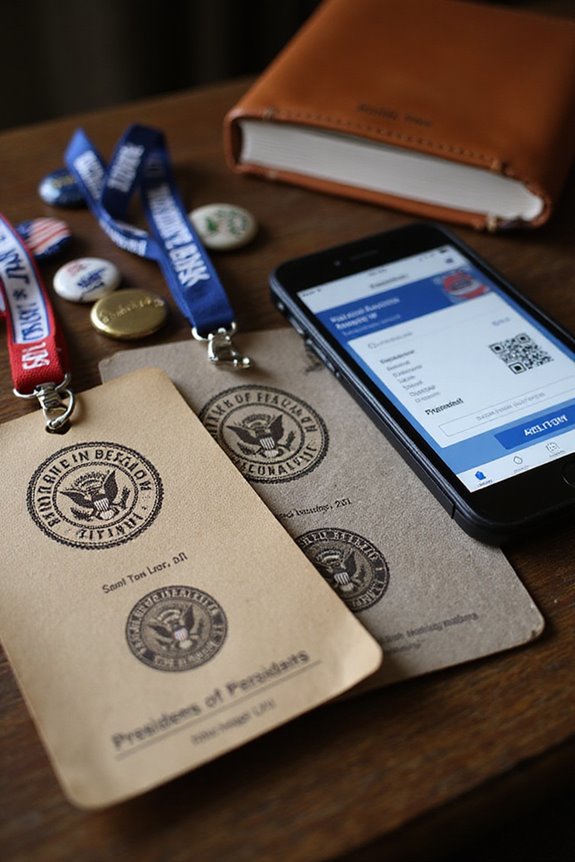
Event badges, whether physical or digital, play an essential role in managing access and enhancing participant experience at political events.
- Digital Convenience: Digital badges are accessible via smartphones or event apps, eliminating the need for physical handling. They can be updated instantly, avoiding delays associated with reprinting physical badges. This digital badge format also prioritizes eco-friendliness, reducing the environmental impact of events. Additionally, adopting minimalistic stationery can further streamline the event organization process by reducing clutter and enhancing focus.
- Security Features: Digital badges offer advanced security options like multi-factor authentication and encryption, considerably reducing the risk of misuse. If a digital badge is lost, it can be deactivated remotely.
- Physical Badges: While physical badges provide visible identification and do not rely on technology, they are more susceptible to loss and duplication. Additionally, physical badges can serve as keepsakes for attendees, fostering excitement and a sense of connection to the event.
Design and Customization Considerations
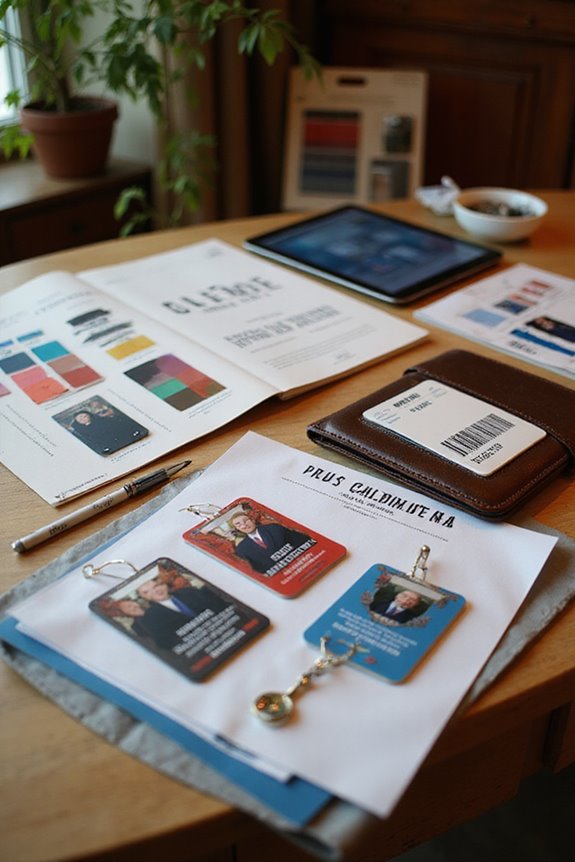
Design and customization are essential components of creating effective event badges. To guarantee success, we should consider several factors:
- Legibility: Use large, bold fonts for names while keeping titles and companies smaller. Clean, sans-serif fonts enhance clarity.
- Color Symbolism: High color contrast improves readability. Incorporating brand colors reinforces identity and supports design trends.
- Layout: Avoid clutter; prioritize essential information to keep badges simple and effective. Utilizing different badge sizes can help differentiate groups effectively.
- Brand Integration: Prominently display logos, social media handles, and sponsor information to enhance visibility.
- Personalization: Utilize variable data printing for unique attendee details, including photos for identification.
- Functional Features: Integrate QR codes for check-in and event information, guaranteeing security with advanced features.
Frequently Asked Questions
How Can I Safely Store My Political Badge Collection?
We’ve seen how a friend’s badge collection deteriorated due to poor storage. To guarantee our badges last, we should use proper badge preservation techniques and secure storage options like acid-free boxes and protective sleeves.
Are There Specific Laws Regarding Badge Distribution at Political Events?
We recognize that badge distribution laws can be complex. It’s essential to follow event access regulations to avoid any legal issues, especially for federal employees. Let’s make certain we’re informed and compliant when handling badges at events.
Can Badges Be Used for Fundraising Purposes?
Absolutely, we can leverage badge sales as effective fundraising strategies. By selling badges, we not only raise funds but also engage our supporters, creating a sense of community and involvement in our cause.
What Are the Best Practices for Badge Recycling After Events?
When considering badge recycling after events, we should focus on badge reuse and eco-friendly options. Setting clear objectives, providing collection points, and offering incentives can considerably enhance participation in our sustainable recycling efforts.
How Do I Create a Digital Badge for My Campaign?
We’ve all experienced the thrill of earning a badge. To create one for our campaign, we can use design tools and badge templates that reflect our brand and engage participants effectively. Let’s get started!





